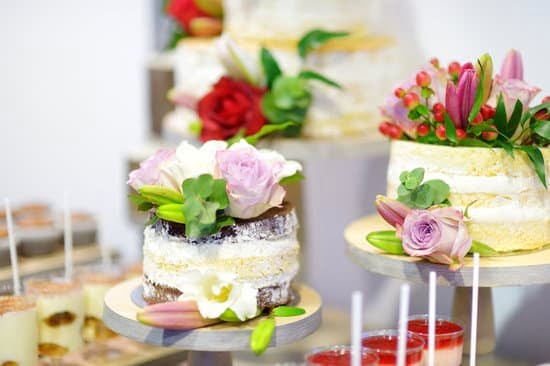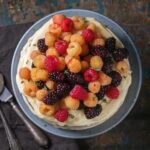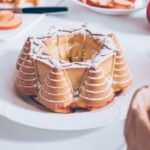How do I decorate a cake? Cake decorating is an essential skill for anyone who loves to bake or wants to create beautiful and delicious desserts. Whether you’re a novice or an experienced baker, understanding the basics of cake decoration can enhance your creations and impress your friends and family.
Cake decorating allows you to express your creativity and personalize your desserts for any occasion, from birthdays to weddings. With the right tools, techniques, and a little practice, you can turn a plain cake into a work of art. In this article, we will take you through the process of cake decoration step by step, covering everything from essential tools and equipment to troubleshooting common mistakes.
From choosing the right frosting to mastering piping techniques and creating intricate designs with fondant, we will provide you with all the information you need to elevate your cake decorating skills. By the end of this article, you’ll be equipped with the knowledge and confidence to take your cake decorating to the next level and impress everyone with your beautifully decorated creations.
Tools and Equipment Needed for Cake Decoration
When it comes to cake decorating, having the right tools and equipment is essential for achieving professional-looking results. Whether you’re a beginner or an experienced baker, there are a few key items that you’ll need in order to decorate a cake effectively.
One of the most important tools for cake decorating is a good quality offset spatula, which is used for spreading and smoothing frosting onto the cake. A set of piping tips and bags are also essential for creating intricate designs with frosting. Additionally, a turntable is helpful for easily rotating the cake while decorating, and a bench scraper can be used to smooth out the sides of the cake.
In terms of equipment, having the right mixing bowls, measuring cups and spoons, and an electric mixer will make it easier to prepare your frosting and icing. It’s also important to have a good quality cake stand or serving platter for displaying your finished creation. These basic tools and equipment are essential for anyone wondering how do I decorate a cake effectively.
Another essential item for cake decorating is a good quality pastry brush, which can be used for applying simple syrups or brushing away excess crumbs before frosting the cake. A cake leveler is also helpful for ensuring that your layers are even and flat. With these essential tools and equipment in your kitchen, you’ll be well-equipped to start decorating beautiful cakes at home.
Different Types of Frosting and Icing and How to Use Them
When it comes to cake decorating, the type of frosting or icing you use can make a big difference in the final look and taste of your creation. There are several different types to choose from, each with its own unique properties and uses. Here are some popular options and how to use them:
1. Buttercream Frosting: This classic frosting is made with butter, powdered sugar, and flavorings such as vanilla or cocoa. It is easy to work with and is great for piping borders, flowers, and other decorations. To use buttercream frosting, simply place it in a piping bag fitted with a desired tip and start decorating your cake.
2. Royal Icing: Made from egg whites, powdered sugar, and lemon juice, royal icing dries hard and is often used for intricate designs and decorations such as flowers, lacework, or gingerbread houses. To use royal icing, place it in a piping bag with a small round tip and carefully pipe your designs onto the cake.
3. Fondant: This pliable icing can be rolled out and draped over cakes to create a smooth finish or cut into shapes for decorations. It is commonly used for wedding cakes or themed designs due to its versatility. To use fondant, roll it out on a surface dusted with powdered sugar or cornstarch to prevent sticking, then carefully drape it over the cake.
4. Cream Cheese Frosting: A popular choice for red velvet cakes or carrot cakes, cream cheese frosting has a tangy flavor that pairs well with certain cake flavors. It can be spread onto cakes or piped into decorative swirls using a piping bag.
Learning how to use each type of frosting and icing effectively will give you more flexibility in creating beautiful designs on your cakes. Experimenting with different techniques will also help you discover which styles suit your preferences and skills best when considering how do I decorate a cake?
Step-by-Step Guide on How to Level and Layer a Cake
Leveling and layering a cake is an essential skill in cake decorating. This process ensures that the cake has an even surface for decorating and results in a professional-looking finished product. Here’s a step-by-step guide on how to level and layer a cake that will elevate your baking game.
Leveling the Cake
Before you begin to decorate your cake, it’s important to ensure that the layers are even. Start by allowing the cake to cool completely after baking. Once cooled, use a long serrated knife to carefully slice off any uneven or domed top of the cake, creating a flat surface. This will provide a stable base for stacking and decorating the layers.
Layering the Cake
Once you have leveled the cake, it’s time to layer it with frosting or filling. Place one of the leveled cakes on a serving plate or cake board, and spread a generous amount of frosting or filling on top. Carefully place the second leveled cake on top of the first layer, making sure it is centered. Repeat this process if you have additional layers, making sure each layer is level before adding the next.
Stacking and Chilling
After you have layered your cake, it’s important to stack it properly for stability. Use dowels or plastic supports to secure the layers if necessary, especially if your cake is multi-tiered. Once stacked, chill the cake in the refrigerator for at least 30 minutes before continuing with decorating. This will firm up the layers and make them easier to work with when applying frosting or fondant.
By following these steps, you can achieve perfectly leveled and layered cakes that serve as blank canvases for your creative decorations and designs. Mastering this fundamental skill is crucial for aspiring bakers who want to take their cake decorating skills to new heights. Now that you know how to level and layer a cake, you’re ready to move on to the next phase of decorating – adding frostings and icings.
Techniques for Piping and Decorating With Fondant
Piping and decorating with fondant are popular techniques for adding beautiful designs and details to cakes. Whether you’re a beginner or an experienced baker, these techniques can take your cake decorating skills to the next level. So, how do I decorate a cake using piping and fondant?
First, let’s talk about piping. Piping is the process of using a pastry bag fitted with a piping tip to create decorative designs on the surface of a cake. There are many different types of piping tips available, each creating a unique design when used properly. Some common designs created through piping include rosettes, shells, dots, and lines.
When it comes to fondant, this pliable icing is perfect for creating smooth, flawless coverings for cakes as well as intricate shapes and designs. Fondant can be rolled out and draped over a cake or shaped into 3D decorations like flowers, figurines, or other creative elements. Using colorful fondant allows decorators to make custom colors for their creations.
Now let’s look at how to use both techniques together. Combining piping with fondant opens up endless possibilities for creating stunning cakes. For example, you can use piped frosting to add details like borders or writing on a fondant-covered cake. Or you can create three-dimensional decorations out of fondant and then use piping to add delicate accents or textures. The combination of these two techniques allows decorators to showcase their creativity in new and exciting ways.
| Piping Tips | Fondant Shapes |
|---|---|
| Rosettes | Flowers |
| Shells | Figurines |
| Dots | Creative Elements |
Tips for Creating Intricate Designs and Patterns on Cakes
Creating intricate designs and patterns on cakes can take your cake decorating skills to the next level, adding a beautiful and professional touch to your creations. Whether you’re looking to add a simple yet elegant design or something more elaborate, there are a variety of techniques you can use to achieve stunning results. From piping intricate details with buttercream to using stencils for patterned designs, the possibilities are endless when it comes to creating visually appealing cakes.
One technique for creating intricate designs on cakes is by using piping bags and various piping tips. This allows you to create detailed borders, flowers, and even intricate lace designs. By practicing different pressure techniques and experimenting with different tips, you can achieve unique and eye-catching designs on your cakes. Additionally, incorporating elements such as edible pearls or dragees can add an extra touch of elegance to your design.
Another popular method for creating intricate patterns on cakes is by using stencils. Stencils come in a wide variety of patterns and designs, allowing you to easily transfer intricate details onto your cake’s surface. By carefully applying royal icing or edible dusting powder over the stencil, you can create stunning patterns that give your cake a professional look with minimal effort.
For those looking to elevate their cake decorating skills even further, learning how to work with fondant opens up endless possibilities for creating intricate designs and patterns on cakes. Fondant allows for smooth finishes and precise detailing, making it perfect for creating everything from delicate floral arrangements to geometric patterns.
In summary, mastering the art of creating intricate designs and patterns on cakes requires patience, practice, and attention to detail. By utilizing piping techniques, stencils, and fondant, you can take your cake decorating skills to new heights and impress both yourself and others with your beautifully designed creations. Whether you’re decorating a cake for a special occasion or simply wanting to enhance your skills as a baker, these tips can help you achieve visually stunning results.
Creative Ideas for Theme-Based Cake Decorations
Theme-based cake decorations are a fun and creative way to add a personalized touch to your cakes for special occasions. Whether it’s a birthday, holiday, or other celebration, incorporating a theme into your cake design can really make it stand out. Here are some creative ideas for theme-based cake decorations:
- Seasonal Themes: Embrace the spirit of the season by decorating your cakes with symbols and colors associated with the time of year. For example, you can use pastel-colored flowers and bunnies for spring, red and green holly for winter, or sunflowers and leaves for fall.
- Character Themes: If the cake is for a child’s birthday or a fan of a particular character or franchise, consider incorporating their favorite characters into the design. You can use edible images, figurines, or piped designs to bring these characters to life on the cake.
- Floral Themes: Flowers are a classic decorative element for cakes and can be used to create elegant and beautiful designs. Consider using fresh flowers, gum paste flowers, or piped buttercream flowers to adorn your cake with a floral theme.
When considering theme-based cake decorations, it’s important to plan ahead and gather any specific tools or decorations that may be needed to bring your design to life. Additionally, don’t be afraid to get creative and think outside the box when brainstorming ideas for theme-based cake decorations. With some imagination and skillful execution, you can create stunning cakes that beautifully reflect the occasion they are meant to celebrate.
Lastly, remember that practice makes perfect when it comes to mastering the art of theme-based cake decoration. Don’t be afraid to experiment with new techniques and designs in order to further develop your skills in this area. And above all else, have fun with it. Theme-based cake decorations provide an opportunity for you to showcase your creativity while making someone’s day extra special with a unique custom creation.
Troubleshooting Common Cake Decorating Mistakes
Crumbly Frosting
One common problem when decorating a cake is dealing with crumbly frosting. This can be frustrating, especially when you’re trying to achieve a smooth and clean finish. One way to prevent this issue is to ensure that your cake is completely cooled before applying the frosting. If your frosting still ends up crumbly, try adding a small amount of milk or cream to it and beat it again until it reaches the desired consistency.
Sunken Cake Layers
Another common issue in cake decorating is dealing with sunken cake layers. This can happen due to undermixing the batter, opening the oven door too early while baking, or having an incorrect oven temperature. To avoid this problem, make sure to properly mix the batter and avoid opening the oven door while the cake is baking. You can also use an oven thermometer to ensure that your oven is at the right temperature.
Fondant Cracking
When working with fondant, one of the most frustrating problems you may encounter is fondant cracking. To prevent this issue, make sure that your cake has a smooth layer of buttercream before applying the fondant.
Knead the fondant until it becomes pliable and roll it out evenly using powdered sugar to prevent sticking. If cracks start to appear on the fondant while covering the cake, gently smooth them out with your fingers and use a small brush dipped in water to adhere any loose edges.
By addressing these common cake decorating mistakes and learning how to troubleshoot them effectively, you will be able to elevate your skills in creating beautifully decorated cakes that are both visually appealing and delicious.
Conclusion
If you’ve made it to the end of this article, then you are well on your way to becoming a pro at cake decorating. With the proper tools, knowledge of frosting and icing, and a few key techniques, you can create beautiful and professional-looking cakes right in your own kitchen.
Remember that practice makes perfect, so don’t be discouraged if your first attempts aren’t perfect. Keep experimenting and trying new things to find what works best for you.
As you continue on your cake decorating journey, don’t be afraid to push yourself out of your comfort zone and try new techniques. Piping with different tips, working with fondant, and creating intricate designs can take your cakes from ordinary to extraordinary. Look for inspiration in various places such as nature, art, or even fashion to come up with unique and creative ideas for theme-based cake decorations.
Finally, seek out additional resources such as online tutorials, books, classes or workshops to further refine your skills. Networking with other cake decorators can also provide valuable insight and tips for taking your cake decorating abilities to the next level. The most important thing is to have fun and enjoy the process of creating delicious works of art that will bring joy to those who get to indulge in them. Remember: practice makes perfect.
Frequently Asked Questions
What Is the Best Way to Decorate a Cake?
The best way to decorate a cake is to start with a smooth layer of frosting or icing and then add creative touches like piped designs, fresh fruit, edible flowers, or colored sprinkles. It’s also important to consider the flavor and theme of the cake when choosing decorations.
How to Decorate Cake in Home Simple?
Decorating a cake at home can be simple by using basic tools like a spatula, piping bags, and tips. You can create designs using different colored frostings or icings, or even try using stencil patterns with powdered sugar. Don’t forget to let your creativity shine through!
How Do You Make a Cake Look Fancy?
To make a cake look fancy, consider incorporating intricate piping techniques for borders and designs. You can also add elegant touches like gold leaf, chocolate shavings, or drizzles of caramel or ganache. Fresh berries or flowers can also add a touch of sophistication to the overall presentation.

Welcome to our cake decorating blog! My name is Destiny Flores, and I am the proud owner of a cake decorating business named Cake Karma. Our mission is to provide delicious, beautiful cakes for all occasions. We specialize in creating custom cakes that are tailored specifically to each customer’s individual needs and tastes.





